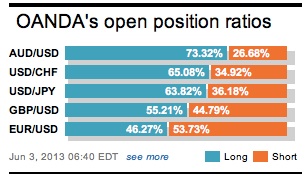Now that the May month-end pricing and rebalancing shenanigans is completed, this market can get back to watching the Nikkei continue to paint the town ‘red,’ along with a stronger yen that’s now worrying a few of the weaker short positions out there. This week the global data schedule is again busy. Market risk appetite will once again be considered the primary market driver that’s expected to be heavily influenced by bond auctions and rate decisions.
Capital market’s two most crowded trades continue to make headlines – long the Nikkei and short Yen. Last night, the Tokyo bourse managed to record its fourth decline in eight sessions amid the Yen’s continuing strength. The stock average pared another -3.7%, to a six week low, mostly pressured by domestic Japan selling interest. In ten day’s the Nikkei has fallen -17% as the dollar claws it way back towards that much watched psychological ¥100 mark. Japanese equities are not alone; investors and the Bank of Japan also have their work cut out with JGB’s.

The BoJ Governor recognizes that caution is also needed as JGB volatility remains high and that excess volatility must be avoided. Japanese authorities must now be officially concerned with both the recent volatile price movements and with yield backing up – very much counter productive to what Abenomics is all about. The governor, not specifically calling out yields, believes that the volatility can be contained by flexibly conducting market operations. It remains to be seen how these market operations will be implemented and until then the market will remain uncertain as to whether the BoJ is committed to holding long-term rates down – leading to a volatile JGB market.
Earlier this morning the UK manufacturing sector happened to expanded at its fastest pace in 12-months (51.3 vs. 50.2). This would suggest that the outgoing BoE Governor King is less likely to be announcing any further stimulus at the two-day policy meeting midweek. The positive expansion was broad based with producers of consumer, intermediate and investment goods all reporting stronger output growth. Along with the service sector, UK manufacturing recovery will add further weight to the BoE wait-and-see approach before policy makers will add any further stimulus. Digging deeper, improved new orders and output happened to lead the pickup in the headline print, again allowing sterling to catch its second wind.

The 17-member single currency is starting this week confined to a fairly tight range. For the most part it has held a small bid on gains made on the back of a slight improvement to a few Euro-zone members PMI’s. The overall market view still remains EUR negative, supported by fundamentals and expressed by the number of speculative shorts in the market place. The US ISM will be the next market focus point later this morning. Investors continue to monitor US Treasuries and the Bund spread – any further widening suggests that the EUR remains a sell strength play.
However, there is the issue that the IMM’s massive dollar longs could see an extended squeeze. According to the most recent CFTC report the world is long of dollars. Investors have managed to add another +$18-billion since May 7 for a combined total of +$42.6-billion net long vs. G10 mostly. However, many of these recent longs have been added at bad levels ahead of a week with key event risk. Certainly not a healthy sign for “long dollar” position holders is to see US yields back up and the dollars back down.

The obvious two key event risks this week will be the ECB meet and the US employment report. The European Governing Council is expected to leave its main policy rates unchanged at the June 6 meeting after having lowered its refinancing rate by -25bp at the last go around. The market should expect policy makers to argue “the conditions are in place for a recovery in economic activity during the second half of 2013.” While Stateside the markets attention will be on this Friday’s jobs report for May—especially since recent labor market news has been mixed. The FX market will be looking at the ISM and NFP data for confirmation of the strong USD rally of the past few weeks. The weak dollar longs will be hoping that they will not be squeezed out before the reports.

Other Links:
It Does Not Get any Easier For EUR Next Week
Dean Popplewell, Director of Currency Analysis and Research @ OANDA MarketPulseFX
This article is for general information purposes only. It is not investment advice or a solution to buy or sell securities. Opinions are the authors; not necessarily that of OANDA Corporation or any of its affiliates, subsidiaries, officers or directors. Leveraged trading is high risk and not suitable for all. You could lose all of your deposited funds.



